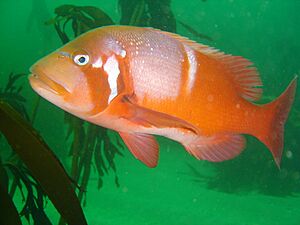Red roman facts for kids
Quick facts for kids Red roman |
|
|---|---|
 |
|
| in False Bay, South Africa | |
| Conservation status | |
| Scientific classification | |
| Synonyms | |
|
The red roman or roman seabream (Chrysoblephus laticeps) is a type of fish that lives in the ocean. It's a ray-finned fish from the family called Sparidae, which includes seabreams and porgies.
This fish is special because it's found only in Southern Africa. You can find it from Namibia all the way to the Eastern Cape in South Africa. The red roman is known for its bright colors and interesting behavior.
Contents
About the Red Roman's Name
The scientific name for the red roman is Chrysoblephus laticeps. It was first described in 1830 by a French scientist named Achille Valenciennes. He named it Chrysophrys laticeps back then.
The second part of its scientific name, laticeps, means "broad head." This name fits the fish well because it has a wide forehead.
What Does a Red Roman Look Like?
The red roman has a body shape that is more oval than other seabreams. Its body is quite deep compared to its length.
As the fish gets older, the area in front of its eyes becomes a bit sunken. The space between its eyes is also wide and a little concave.
This fish is very colorful! Its head, body, and fins are a bright orange. It also has a cool blue stripe between its eyes. You might see a white, saddle-like mark on its back, just below some of its dorsal fin spines.
The red roman has two main fins on its back:
- The dorsal fin has 11 or 12 strong spines and 10 or 11 soft rays.
- The anal fin has 3 spines and between 7 and 9 soft rays.
Most red romans are about 32 centimeters (about 12.5 inches) long. However, some can grow up to 50 centimeters (about 19.5 inches)!
Where Do Red Romans Live?
The red roman is found only in the waters off Southern Africa. This includes parts of the southeastern Atlantic Ocean and the southwestern Indian Ocean.
You can find them from northern Namibia to Durban in KwaZulu-Natal, South Africa. They live in depths from 0 to 100 meters (about 0 to 330 feet). They prefer to live on reefs, both close to shore and further out in deeper water.
Red Roman Life and Behavior
Red romans have an interesting way of reproducing. They are protogynous hermaphrodites. This means they are born as females, and as they grow older, some of them change into males.
When it's time to lay eggs, a male and female red roman form a pair. They perform a special courtship dance before releasing their eggs high above the seafloor.
Studies in South Africa show that individual red romans usually stay in their own small areas, called territories. These territories can be about 1,000 to 3,000 square meters (about 10,700 to 32,300 square feet). This small home range suggests that young red romans mostly spread out as tiny larvae floating in the water.
At night, red romans are much less active. If the water gets very cold, they will hide in caves to stay safe. During the time when they are laying eggs, female fish might swim outside their usual home areas.
Fishing and Conservation
The red roman is a popular fish for people who enjoy line fishing. People catch them from the shore or from boats close to the coast. Line fishing is generally a gentle way to fish and doesn't harm the environment much.
However, other fishing methods, like spearfishing, can lead to too many fish being caught. This has caused the number of red romans to go down in some areas, like Port Elizabeth and False Bay. Because red romans grow slowly, they are more easily affected by overfishing.
The good news is that in Marine Protected Areas (special ocean areas where fishing is limited), the numbers of red romans have started to recover. This shows that protecting their habitats helps them thrive.


